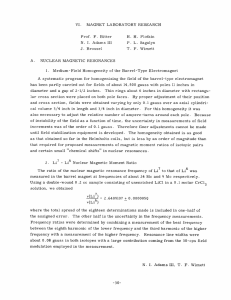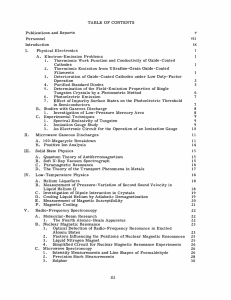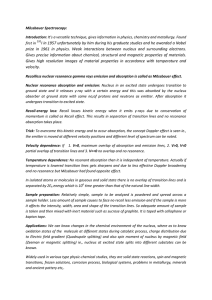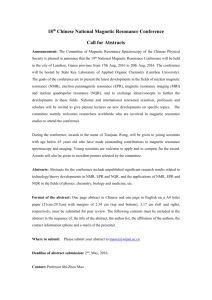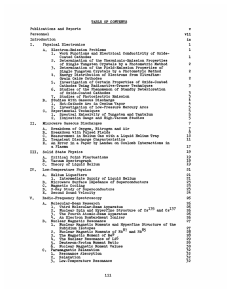NUCLEAR MAGNETIC RESONANCE AND HYPERFINE ... V. A. C. Melissinos
advertisement
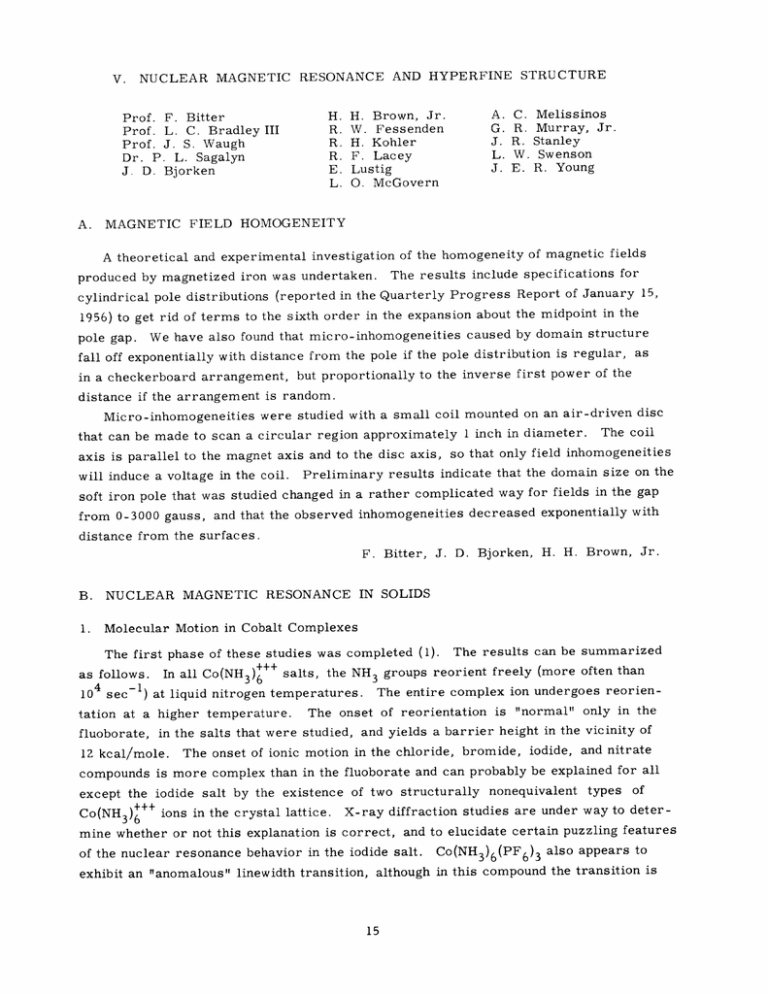
NUCLEAR MAGNETIC V. H. Brown, Jr. W. Fessenden H. Kohler F. Lacey Lustig O. McGovern H. R. R. R. E. L. Prof. F. Bitter Prof. L. C. BradleyIII Prof. J. S. Waugh Dr. P. L. Sagalyn J. D. Bjorken A. RESONANCE AND HYPERFINE STRUCTURE A. G. J. L. J. C. R. R. W. E. Melissinos Murray, Jr. Stanley Swenson R. Young MAGNETIC FIELD HOMOGENEITY A theoretical and experimental investigation of the homogeneity of magnetic fields The results include specifications for produced by magnetized iron was undertaken. cylindrical pole distributions (reported in the Quarterly Progress Report of January 15, 1956) to get rid of terms to the sixth order in the expansion about the midpoint in the We have also found that micro-inhomogeneities caused by domain structure fall off exponentially with distance from the pole if the pole distribution is regular, as in a checkerboard arrangement, but proportionally to the inverse first power of the pole gap. distance if the arrangement is random. Micro-inhomogeneities were studied with a small coil mounted on an air-driven disc that can be made to scan a circular region approximately 1 inch in diameter. The coil axis is parallel to the magnet axis and to the disc axis, so that only field inhomogeneities will induce a voltage in the coil. Preliminary results indicate that the domain size on the soft iron pole that was studied changed in a rather complicated way for fields in the gap from 0-3000 gauss, and that the observed inhomogeneities decreased exponentially with distance from the surfaces. F. B. NUCLEAR MAGNETIC RESONANCE 1. Molecular Motion in Cobalt Complexes Bitter, J. IN SOLIDS The first phase of these studies was completed (1). as follows. 104 sec - In all Co(NH 3 ) 6 The results can be summarized salts, the NH 3 groups reorient freely (more often than 1) at liquid nitrogen temperatures. tation at a higher temperature. fluoborate, D. Bjorken, H. H. Brown, Jr. The entire complex ion undergoes reorien- The onset of reorientation is "normal" only in the in the salts that were studied, and yields a barrier height in the vicinity of The onset of ionic motion in the chloride, bromide, iodide, and nitrate compounds is more complex than in the fluoborate and can probably be explained for all except the iodide salt by the existence of two structurally nonequivalent types of 12 kcal/mole. Co(NH 3 ) 6 ions in the crystal lattice. X-ray diffraction studies are under way to deter- mine whether or not this explanation is correct, and to elucidate certain puzzling features of the nuclear resonance behavior in the iodide salt. Co(NH 3 ) 6 (PF 6 ) 3 also appears to exhibit an "anomalous" linewidth transition, although in this compound the transition is (V. NUCLEAR MAGNETIC RESONANCE) just beginning at the temperature at which the salt begins to decompose with the release of ammonia. In general, the barrier heights that were determined are reasonable for the salts investigated. The work is being extended to include some substituted Co(NH 3 ) 6 salts that, in qualitative experiments, were found to have high barriers, which would be expected from their lower ionic symmetry. G. R. Murray, Jr., J. S. Waugh References 1. This work is described in a Ph. D. Thesis submitted to the Department of Physics, M.I.T., by G. R. Murray, Jr., June 1956. 2. The Rotation of Methyl Groups in Solid Acetylenic Hydrocarbons Methyl groups in dimethyl acetylene and dimethyl diacetylene are reorienting rapidly at the temperature of liquid nitrogen. When the temperature is raised above this point, there appears to be a slight broadening of the nuclear resonance line, the origin of which is now being investigated. Experiments at lower temperatures on the corresponding trifluoromethyl compounds will be made in order to find the region in which methyl reorientation begins. E. Lustig, J. S. Waugh 3. Chemical Shifts in Aromatic Compounds Pople recently published (1) a theory for the qualitative prediction of positions of chemically shifted resonances of protons in condensed aromatic hydrocarbons, on the basis of a free-electron model. We recently recorded the spectra of 2, 2-paracyclophane, dibenzyl, sodium cyclopentadienide, ferrocene, rhenium dicyclopentadienyl hydride and 10-paracyclane in order to investigate the validity of the theory. None of the results seem to support Pople's predictions. It may be significant that Pople's theory embodies the same assumptions as those of Pauling's theory of diamagnetic anisotropy and appears to fail in the same cases. Experiments continue in an attempt to establish the exact boundaries of the region of applicability of Pople's theory and the nature of the modifications that must be made to rescue it. J. S. WVaugh References 1. J. A. Pople, J. Chem. Phys. 24, 1111 (May 1956). (V. C. NUCLEAR MAGNETIC RESONANCE) ISOTOPE SHIFT BETWEEN MERCURY 19 7 The ultraviolet absorption spectroscope described in the Quarterly Progress Report AND 197 1956, continues to operate reliably. A method was devised for displaying on an oscilloscope the hyperfine structure in absorption of a given sample of mercury. The accuracy, as can be seen from Fig. V-1, is poor and does not compare favorably of January 15, with the quantitative point-by-point plot made with the dc bridge, but the device is very 197 that useful for quick analysis of the natural mercury content of preparations of Hg are made in the M. I. T. cyclotron. This rough analysis was performed often, for a con197 197" siderable amount of difficulty was experienced in preparing samples of Hg and which were free from contamination by natural mercury. There are five main absorption troughs of natural mercury (see Fig. V-1) which effectively hide the expected five In other words, the radio-mercury must have absorption troughs of Hg 1 9 7 and 197, very high specific activity; an acceptable sample would have to be at least 50 per cent 19 7 197* Hg and The targets from which the radio-isotopes are produced are pieces of gold foil. These are freed from mercury by prolonged heating in a vacuum furnace at a few degrees below the melting point of gold. The gold is left very pure but its surface is so clean that it will swiftly absorb mercury vapor from the air of the laboratory and from the helium atmosphere in the cyclotron target chamber. A great amount of effort was expended on the problem of preventing the gold from picking up stray natural mercury. Exact expressions were worked out for the transmission of a Doppler-broadened incident line through a gas of absorbing atoms. This relative transmission is a function of: k o , the photon capture cross section; N, the number of absorbers per unit volume; L, the thickness of the absorbing gas; x, the wavelength, measured from the center of the absorption line in units related to the Doppler width; y, the difference in the mean wavelengths of the incident line and the absorption trough, in units related to the Doppler width; and p, the ratio of the temperatures of the emission lamp and the absorbing gas. Fig. V-1. Rough absorption curve for natural mercury (from oscilloscope picture). (V. NUCLEAR MAGNETIC RESONANCE) 0 Probability of transmission of an incident I' photon 0 Spectral distributionof emission line from lamp 1.0- "Scanning curve" relative intensity 0 transmitted SCANNING FIELD Fig. V-2. Derivation of theoretical scanning curve. The theoretical derivation of the relative transmission is indicated below and in Fig. V-2. Incident Beam Absorption Cell Transmitted Beam II Total intensity I N atoms/cc Total intensity I Spectral distribution k absorption coefficient Spectral distribution io =I() Probability of trans mission of photon with \ wavelength x exp[-P(x+y)~] ) = exp (-k NLe The instrument measures IoIox ffI ox dx dx - k NLe-X2j 'I=I (pC - (x+yl)2 TI (V. NUCLEAR MAGNETIC RESONANCE) It can be shown that (kNL)n exp (nT- - p- P) y2 1/2 I 00 n! (n+p)1/2 n=O This expression which gives the form of the "scanning curve," shown in Fig. V-Z, has a minimum at the bottom of the trough where y = 0. I (-koN L)n 1/2z min In this case n=0 n! (n+p)/2 p= This function is plotted in Fig. V-3 for tion cell at the same temperature. 1, that is, with emission lamp and absorp- These expressions were derived and tables of their 1.O CURVE OF .9 O ) x exp(-pe 2 -x 2_ x = o -n0n .8 2 3 4 5 - Fig. V-3. 6 7 p = kN L Calibration curve. 8 9 (p)n n nl 10 (V. NUCLEAR MAGNETIC RESONANCE) values were prepared; these, together with further calculations concerning the form of a self-absorbed line, will be published later. J. E. R. Young D. HYPERFINE STRUCTURE OF THE 3P 1 STATE OF MERCURY BY DOUBLERESONANCE METHODS 1. In a Magnetic Field The main object of our efforts was the improvement of the equipment for studying microwave transitions in the 3P 1 state of mercury to achieve greater accuracy. We have: Completely stabilized the Hg 19 8 light source (microwave arc). 2. Used a self-balancing Leeds and Northrup strip-chart recorder. 3. Increased the microwave power so that "self-reversal" can be easily observed. 4. Obtained enriched samples of Hg 199 and Hg 201 5. Replaced the sinusoidal sweep of the resonance magnet with a linear (triangular) 1. one. With the improved apparatus, a new exact "scanning curve" was obtained for the even isotopes, the signal-to-noise ratio of the resonance being of the order of 20. Resonance was also observed in the F = 3/2 level of Hg 9 9 with a signal-to-noise ratio of better than 5, and a preliminary "scanning curve" was made. A. C. Melissinos, 2. P. L. Sagalyn In Zero Magnetic Field A method for measuring the odd isotope hyperfine structure of the 3P 1 state of mercury with an error of less than one part in 10, 000 was worked out in some detail for the F = 3/2 to F = 1/2 separation in Hg Z 0 1 . (The 3/2 to 1/2 separation in Hg 2 0 1 is approximately 7. 6 kmc; the 3/2 to 5/2 separation in Hg 2 0 1 is approximately 14. O0kmc; the single line of Hg 19 8 nearly coincides with the 3/2 line of Hg201.) Excitation of Hg 2 0 1, F = 3/2, (and unavoidably of Hg 19 8 ) in natural mercury vapor is accomplished by radiation from an Hg 19 8 lamp. Transitions from the F = 3/2 state 201 to the F = 1/2 state in Hg are induced by the microwave fields of variable frequency in the waveguide (see Fig. V-4), if and only if the frequency corresponds to one of the approximate given separations. Discrimination is obtained by using a cell of Hg1 9 8 vapor, which absorbs heavily the part of the scattered radiation that consists of Hg 201 19 8 , and transmits the part that consists of Hg 2 0 1 , F = 1/2. Detection of this radiation is accomplished with photomultiplier I. Monitoring of the reradiated light intensity, which is subject to unpredictable variation both from lamp intensity changes and resonance cell density changes, is accomplished by a bridge-circuit F = 3/2 and Hg NUCLEAR MAGNETIC RESONANCE) (V. PHOTOTUBE Il "I QUARTZ PLATE PHOTOTUBE I Hg .NATURAL NATURAL Hg RESONANCE CELL Hg Hg19 Fig. V-4. ABSORPTION CELL LAMP Diagram of apparatus. measurement of the ratios of the outputs of photomultipliers I and II (see Fig. V-4). In order to estimate signal and signal to noise, we need knowledge of the lamp intensity, and an approximate calculation of the following, for both off and on resonance con198 201 in the resonance cell for both off and on and Hg8 , F = 3/ ditions: excitation of Hg microwave resonance conditions; transition probability from the F = 3/2 to F = 1/2 state for the known microwave field strengths; discrimination percentage of the Hg198 cell 201 1988 201 0 1, , 1/2; and detection efficiencies of the photo3/2, Hg 9 and Hg against Hg multipliers. Lamp intensities were measured absolutely with a commercial radiation thermopile. The calculations mentioned above were made very roughly. The result is a signal-tonoise estimate of 10, 000. Details of the calculations will be presented later. The measurement described above can be applied directly to the F = 3/2 to F = 5/2 Z0 1 transition in Hg 2 0 , and, with modification, to the F = 1/2 to F = 5/2 transition in Hg 1 as well as the F = 3/2 to F = 1/2 transition in Hg 99 R. H. Kohler 1


